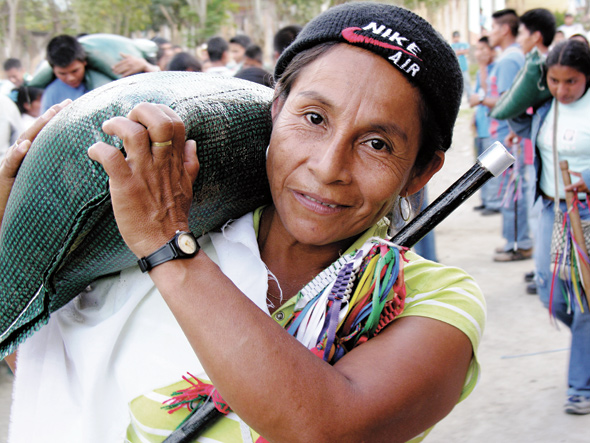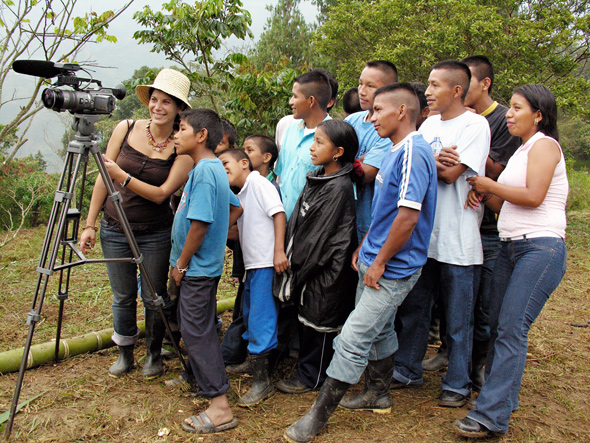
“In Colombia, we are living in a war that is not ours.”
This statement by Flor Ilva, one of the subjects of first-time filmmaker Nicole Karsin’s We Women Warriors, captures the striking premise of the documentary.
The film manages to condense the multifaceted conflict of Colombia by focusing on the account of three women: Doris, a tribal leader of the Awá people; Ludis, a Kankuamo widow who is falsely accused of the murder of 15 policemen; and Flor Ilva, the first female governor of her Nasa tribal government, who organizes a peaceful dismantlement of police barracks.
The storytelling in We Women Warriors masterfully connects the separate story threads; Karsin uses the metaphor of weaving throughout the film to represent strength through community and what she refers to as “the tribal tradition of collective actions,” but this metaphor is equally apt to describe Karsin’s complex narrative.
By placing such an emphasis on the documentary’s subjects and their tales, Karsin also dodges the common pitfall
of call-to-action social-issue films: a heavy-handed “white savior” complex. There is no savior from the First World here—all the activism, each impetus, comes from the Colombian indigenous people themselves. Through Karsin, they are simply given a voice in American media.
“I was drawn to telling this story through the point of view of several female leaders I had the good fortune of meeting,” Karsin said. In 2002, after graduating from Columbia University’s Graduate School of Journalism, Karsin moved to Bogotá to work as an independent print and radio journalist. During the seven subsequent years she lived in the country, three of which were spent shooting WeWomen Warriors, she was exposed to the struggle of Colombia’s indigenous population, of whom, she said, nearly a third is in danger of extinction because of the armed violence by the army, paramilitary and insurgent fighters.
“My growing awareness of these ongoing atrocities compelled me to make this film,” Karsin said. Through her film, she hopes to “shine a light on these remarkable female leaders who were using peaceful methods to transform their lives and transcend opposition.”
As a woman herself, Karsin acknowledges the significance of these leaders’ gender in a commonly patriarchal system. “History is generally not told through a female perspective,” she said, and while women’s rights have progressed, “women in Colombia are afflicted by sexual violence perpetrated by combatants waging war in their regions.”
In addition, many of the men in these communities have been killed, forcing their wives to single handedly raise their children in this dangerous environment. These women drive the film, each with an emotionally evocative history that invites discussion on solutions to the cycle of violence in Colombia.

One particularly chilling moment in the film occurs as Ludis describes her son’s and her nephew’s reactions to their fathers’ deaths. Because her son’s father died at the hands of the paramilitary, she says, her son tells her that he will become a rebel fighter. As for her nephew, he swears to join the paramilitary to avenge his father, who was murdered by rebels.
“And if our paths cross?” the boys ask each other. “We’ll kill each other.”
Karsin’s own path was a difficult one. At times, she said, she worked with a small and dedicated Colombian crew. However, having grown “savvy about traveling in Colombia’s conflict zones,” she said, “I sometimes became a one-person production team, shooting alone in the Colombian countryside.”
Three years of postproduction, two fellowships, and one Kickstarter campaign later, the completed film finally premiered in NYC at the IFC Center on August 10, the day after the International Day of the World’s Indigenous Peoples.
“Hopefully, my film will be a vehicle that transmits these women’s voices and provides worldwide audiences access to their neglected crisis and valiant struggles to survive,” Karsin said. While the film’s depiction of atrocities may “outrage and distress” viewers, Karsin reiterated that it also seeks to inspire them. “It will show them what can be achieved in the most difficult of contexts and illustrate a model of peaceful struggle that deserves U.S. citizens’ strong support.”
Text by Daniela Ricci
Photos by Pablo Serrano

